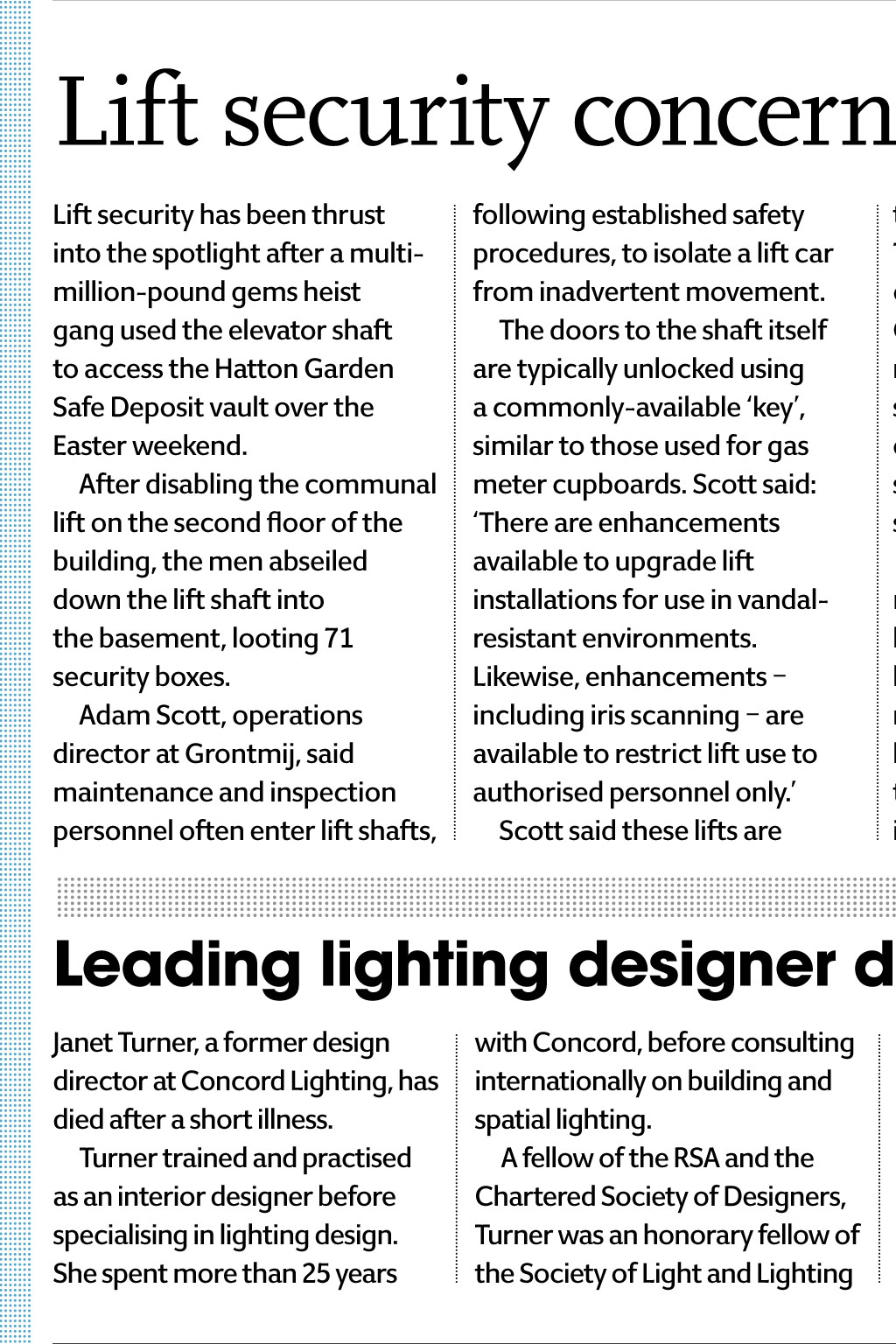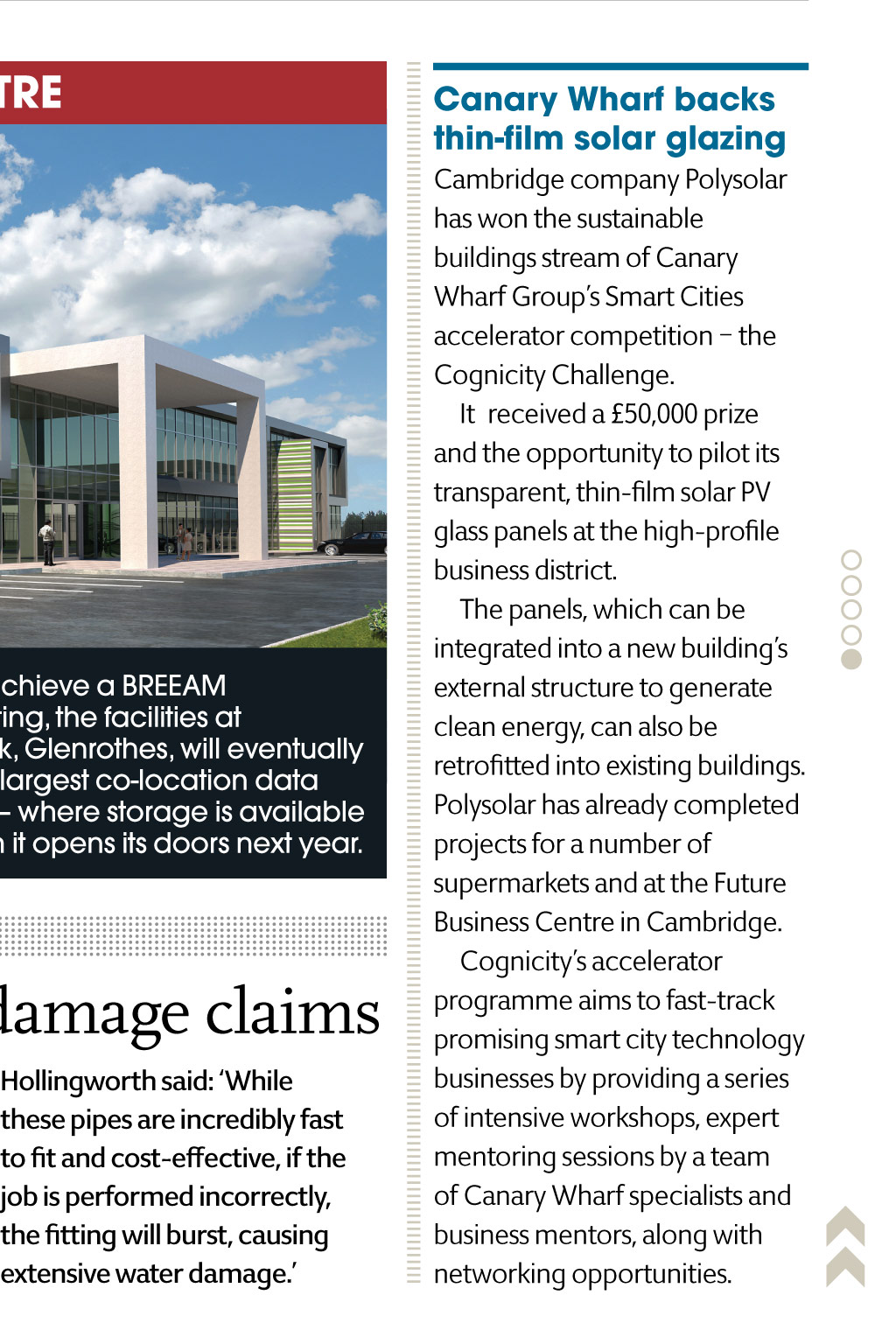




















nEWs All the latest news from around the building industry Industry will suffer fallout from political uncertainty Slower construction growth predicted for 2016 and 2017 A hangover from the General Election could damage construction-industry growth in two years time, according to forecasters at the Construction Products Association (CPA). Output is expected to continue growing this year, by 5.5%, before slowing during 2016 and 2017, to 4% and 3.4% respectively. The CPA has said the industry would have to work with the new government to address the need for greater investment in capacity and skills. While the construction sector is growing at double the rate of the rest of the UK economy thanks to activity in private housing, infrastructure and commercial building the most uncertain election in more than 40 years will start to have a negative impact, according to the CPAs economics director Noble Francis. The lag between contracts and work on the ground means that construction activity in 2015 probably wont be impacted, since the majority of work for the year has already been planned, he said. Instead, we expect a break in private and public investment this year for future projects, which in turn will lead to slowerconstruction growth in 2016 and 2017. Francis added that uncertainty over future government policies, such as Help to Buy, would damage growth in the house-building ...but surge in planning approvals bodes well for strong finish to 2015 Planning approvals in the first two months of this year jumped by more than a third compared with the same period last year. According to figures from construction information specialist Glenigan, planning approvals in January and February were up by 36% compared with the same period in 2014. These include a 54% increase in non-residential approvals. With more projects now expected to start on site later this year, observers are predicting a strong finish to 2015, although the overall value of projects has dropped compared with last year. The overhang of last years relatively muted rise in approvals, coupled with some private-sector clients pursuing a wait-and-see approach during the run-up to the General Election, may keep starts subdued into the second quarter, said Allan Wiln, economics director at Glenigan. BIM uptake on pause Many practices blame lack of time, cost or expertise Engineering and construction professionals believe the development of building information modelling (BIM) is largely moving in the right direction, according to this years NBS National BIM Survey. But there has been a pause in adoption with a significant number of practices still not seeing the advantages, the researchers said. More than 80% of respondents to the fifth annual survey believe that BIM will be made compulsory on public sector projects, and 70% said the government would stick to the plan set out in its construction strategy to implement 3D collaborative Level 2 BIM. Most respondents believe progress is on the right track, but only a quarter said the UK was a world leader. A further 45% remain ambivalent about the role of BIM, although most think it will help reduce project costs and time; and 41% see it as a tool that can help cut carbon emissions. However, cost plus lack of expertise and training remain major barriers to BIM adoption, according to the survey, with many professionals saying they didnt have enough time to master the techniques required. There has also been a small drop in the proportion of firms adopting the approach: 48% compared with 54% last year. On top of that finding, 63% said a lack of client demand was slowing their adoption of BIM. Despite this, David Philp, head of the UK BIM Task Group, said he was heartened that the majority of the industry felt the government was on track. Among BIM adopters: 59% had experienced cost efficiencies; 56% an improvement in client outcomes; 51% an increase in the speed of delivery; and 48% an increase in profitability. However, this bank of prospective projects with detailed permissions bodes well for growth during the second half of this year, especially if a credible government emerges quickly from the aftermath of the election. There are still considerable differences in activity between regions in England, with the North East, Yorkshire, the East Midlands, the East and the South East all experiencing significant rises in the value of projects starting on site, compared to a year earlier. However, the value of projects in London, the South West, the West Midlands and the North West fell. London still easily boasted the largest value of project starts of any UK region in the first quarter, at 2.2bn, but that figure was down by 13% on the first three months of 2014. sector, despite the national shortage of affordable homes. The CPA is forecasting that private house-building will still be 19.2% lower than its prerecession peak in 2007. Similarly, increases in commercial activity are likely to be constrained by a hiatus in business investment this year, due to the election, with growth in the sector expected to slow to 5.2% in 2016 and 4.4% in 2017, added Francis. One area that is expected to be largely unaffected by the General Election is infrastructure activity, which is predicted to continue growing well into 2018. See CIBSE technical director Hywel Davies overview of the main political parties policies here. talent shortages hampering projects Nine out of 10 construction project owners working in the public sector experienced underperforming projects in the last year, caused by a shortage of skilled labour, poor contractor performance or planning issues, a KPMG survey has revealed. Results from the annual global construction project owners survey found nearly half of respondents were experiencing shortages in skilled labour, with 69% requiring external assistance to support the existing workforce to deliver projects. cHP key to nHs carbon saving targets The NHS could achieve major carbon and cost savings in building energy use by using more combined heat and power (CHP), according to the National Audit Office. It estimates the NHS could save 180m a year through carbonsaving measures. CHP provider Ener-G said the Heart of England NHS Foundation Trust would make energy and operational savings of nearly 1.6m a year by using low carbon heat and power, and refurbishing its electricity, heating and cooling infrastructure. fox wins symposium award CIBSE technical event sold out at UCL There was a full house at the two-day CIBSE Technical Symposium hosted by UCL last month. The event brought together 200 attendees for a programme, featuring more than 50 debates, Award winner presentations and poster sessions. Sergio Fox Sergio Fox, from Architecture without Engineers, who introduced the symposium theme of simple buildings, better buildings with a study on Danish buildings, won the award for most effective delivery of material. And the accolade for the most significant contribution went jointly to Michael Lim, from Aecom, and Steve Harper, from Galliard Homes, for their paper on the Seager Distillery case study. CIBSE vice-president Tadj Oreszczyn spoke of the challenges facing building services engineers over the next 50 years and highlighted the importance of attempting to make buildings zero carbon to help tackle the challenges caused by rising global temperatures. He described how new greenhouse gas emissions targets including those expected to be agreed in UN climate change talks in December made 2015 a critical year for setting the trajectory for the remainder of the century. Next years symposium will be held at Heriot-Watt University, in Edinburgh. Selected papers can be download at here. Lift security concerns after jewel heist Lift security has been thrust into the spotlight after a multimillion-pound gems heist gang used the elevator shaft to access the Hatton Garden Safe Deposit vault over the Easter weekend. After disabling the communal lift on the second floor of the building, the men abseiled down the lift shaft into the basement, looting 71 security boxes. Adam Scott, operations director at Grontmij, said maintenance and inspection personnel often enter lift shafts, following established safety procedures, to isolate a lift car from inadvertent movement. The doors to the shaft itself are typically unlocked using a commonly-available key, similar to those used for gas meter cupboards. Scott said: There are enhancements available to upgrade lift installations for use in vandalresistant environments. Likewise, enhancements including iris scanning are available to restrict lift use to authorised personnel only. Scott said these lifts are typically designed to BS EN8171, which defines different categories of vandal-resistance. Category 2 includes the requirement for a security system to prevent opening of the landing door with the standard key, unless the security system has been deactivated. Scott said it was not mandatory to design lifts for high-security buildings to a higher category of vandalresistance. However, this was likely to be considered during the design stage and adopted if it was felt appropriate. leading lighting designer dies, aged 78 Janet Turner, a former design director at Concord Lighting, has died after a short illness. Turner trained and practised as an interior designer before specialising in lighting design. She spent more than 25 years with Concord, before consulting internationally on building and spatial lighting. A fellow of the RSA and the Chartered Society of Designers, Turner was an honorary fellow of the Society of Light and Lighting and the Royal Incorporation of Architects in Scotland. She was passionate about education and lectured extensively on all aspects of lighting in America, the Middle East, Japan, Iceland, Europe, BIoMass to PoWEr GIant data cEntrE A 100m cloud-hosting data centre in Fife is aiming to be one of the most efficient in the world with a power usage efficiency rating of just 1.15 and energy drawn from the UKs largest biomass power plant, which has been built next door. Designed to achieve a BREEAM outstanding rating, the facilities at Queensway Park, Glenrothes, will eventually form Scotlands largest co-location data centre campus where storage is available for rental when it opens its doors next year. Poor installation leads to water-damage claims Poorly installed push-fit connections are being blamed for a number of expensive water-damage insurance claims. Construction insurer ECIC has seen a marked increase in claims linked to connections bursting under pressure. In one case, more than 500,000 of water damage was caused to a care home. ECIC claims manager Ian Hollingworth said: While these pipes are incredibly fast to fit and cost-effective, if the job is performed incorrectly, the fitting will burst, causing extensive waterdamage. Russia, Slovenia, New Zealand, Australia, Scandinavia and China. She is survived by her partner, architect Christophe Egret, her children Joanna and Jake, and grandchildren Amber and Dexter. canary Wharf backs thin-film solar glazing Cambridge company Polysolar has won the sustainable buildings stream of Canary Wharf Groups Smart Cities accelerator competition the Cognicity Challenge. Itreceived a 50,000 prize and the opportunity to pilot its transparent, thin-film solar PV glass panels at the high-profile business district. The panels, which can be integrated into a new buildings external structure to generate clean energy, can also be retrofitted into existing buildings. Polysolar has already completed projects for a number of supermarkets and at the Future Business Centre in Cambridge. Cognicitys accelerator programme aims to fast-track promising smart city technology businesses by providing a series of intensive workshops, expert mentoring sessions by a team of Canary Wharf specialists and business mentors, along with networking opportunities.